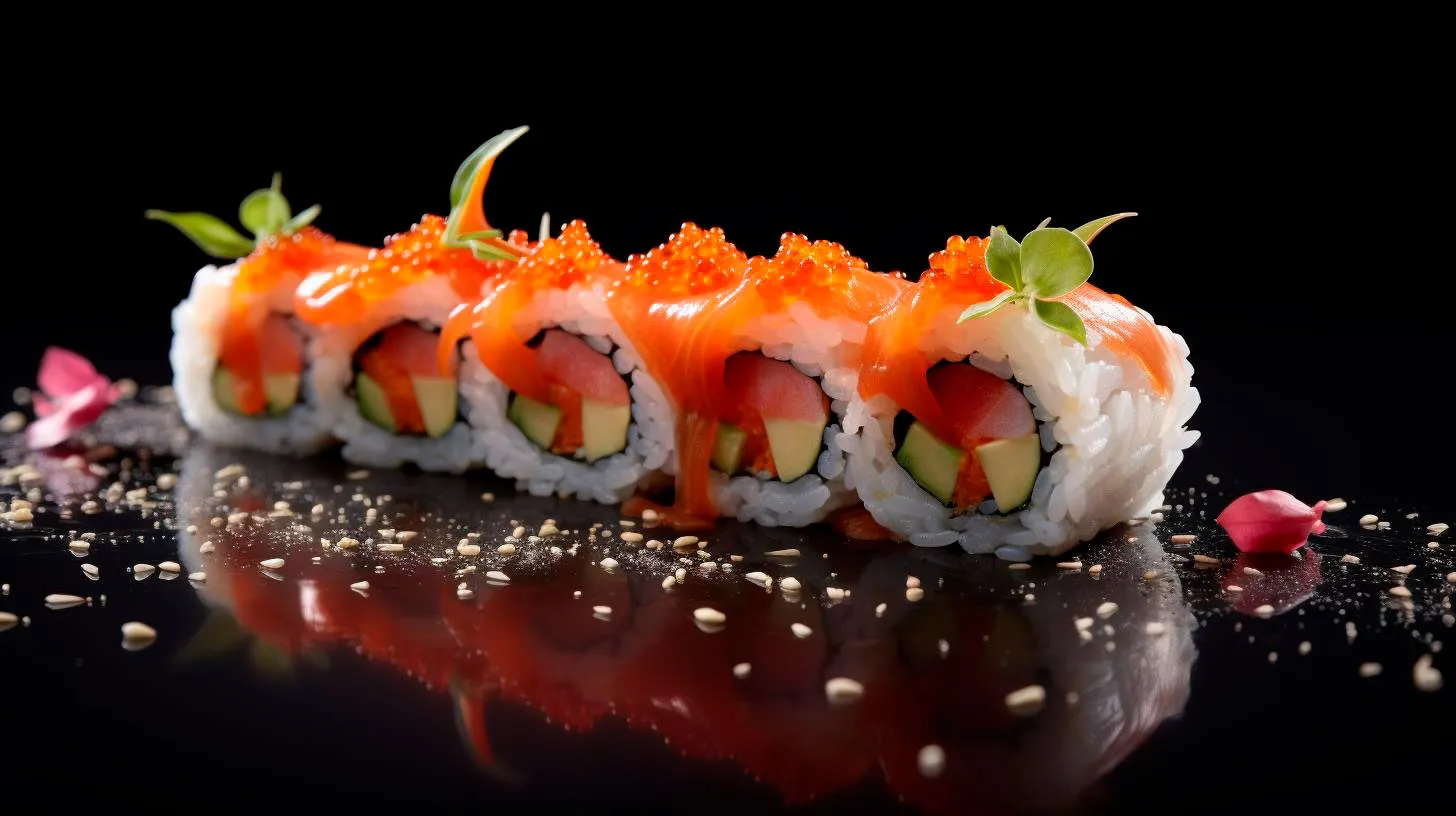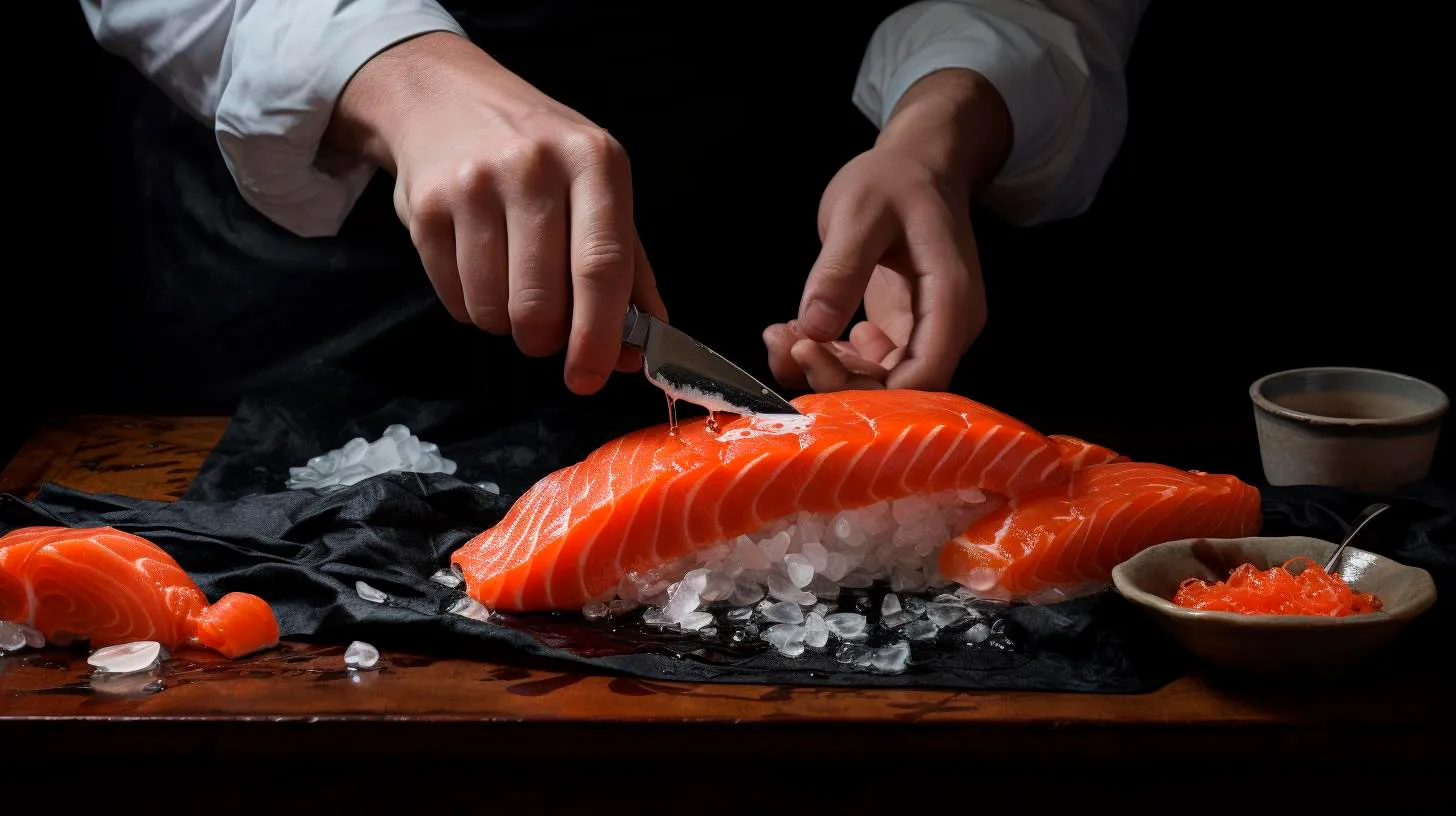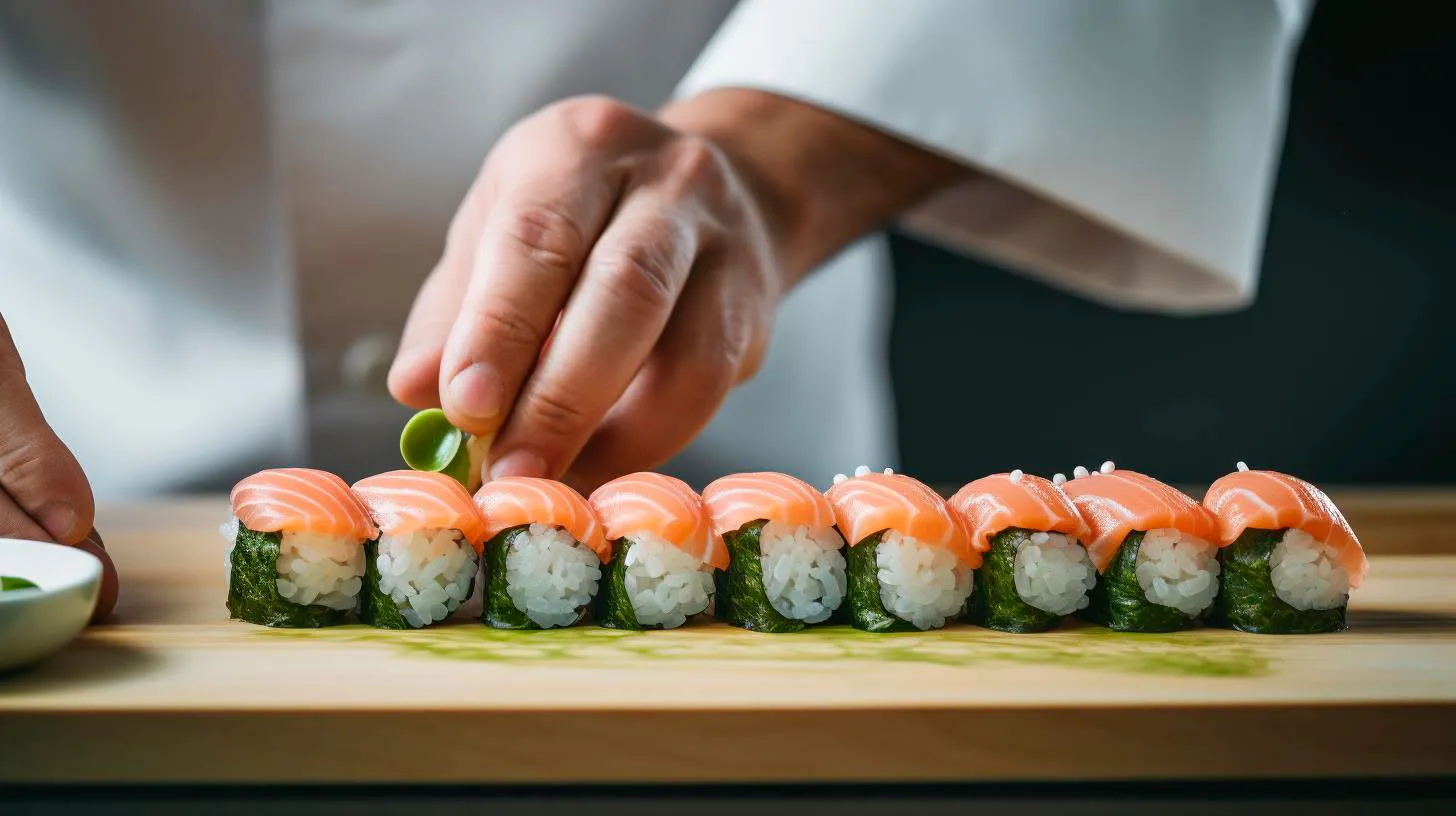Sushi: From Traditional Dish to Modern Fusion Cuisine
The Origins of Sushi
Sushi dates back to the 2nd century A.D. in Southeast Asia, where it initially served as a method of preserving fish by fermenting it with rice and salt. The rice acted as a natural preservative, allowing people to enjoy fish for extended periods. However, it wasn’t until the 19th century in Japan that sushi as we know it today started taking shape.
Originally, sushi was a street food commonly sold in small stalls or food carts. Traditional sushi, known as Edomae sushi, was made by topping vinegar-seasoned rice with various ingredients such as raw fish, cooked seafood, or pickled vegetables. The focus was on simplicity and highlighting the flavors of individual components.
The Transition to Modern Sushi
In the early 20th century, sushi underwent a significant transformation with the invention of refrigeration and advances in transportation. This allowed sushi to be served at restaurants, extending its popularity beyond street food. It was during this time that nigiri sushi, a hand-pressed combination of rice and fish, gained traction.
Fast forward to the 1960s, when sushi began to make its way to the United States. At first, it was primarily enjoyed by Japanese immigrants and those familiar with Japanese cuisine. However, as international travel increased and cultural barriers broke down, sushi started gaining mainstream popularity.
As sushi spread globally, chefs began experimenting with local ingredients and flavors, leading to the birth of fusion sushi. This innovative approach combined traditional Japanese sushi techniques with ingredients from other cuisines, resulting in unique and exciting flavor profiles.
The Rise of Fusion Sushi
Fusion sushi has become a major trend in the culinary world, appealing to adventurous eaters and food enthusiasts. Here are some key features and advantages of fusion sushi:
- Creative Ingredient Combinations: Fusion sushi pushes the boundaries of traditional flavors by incorporating ingredients like avocado, cream cheese, mango, and even non-seafood items.
- International Influence: Fusion sushi draws inspiration from various culinary traditions, including Chinese, Korean, Thai, and Western cuisines, resulting in dynamic and diverse flavor profiles.
- Presentation and Aesthetics: Fusion sushi often takes a unique approach to presentation, with colorful ingredients and artistic arrangements that provide a visual feast alongside a culinary experience.
As fusion sushi gained popularity, it expanded into different styles, including sushi burritos, sushi pizzas, and sushi bowls. These variations appealed to those seeking a more casual and accessible dining experience without compromising on taste.
The Growing Health Trend
In recent years, the health benefits of sushi have become increasingly recognized. Sushi is naturally low in fat, high in protein, and packed with essential vitamins and minerals. The use of fresh seafood in sushi provides omega-3 fatty acids, which are known for their heart-healthy properties.
Furthermore, fusion sushi options often incorporate vegetables, whole grains, and lean proteins, making them a nutritious choice for those looking to maintain a balanced diet. This healthier twist has contributed to the enduring popularity of sushi as a go-to option for health-conscious individuals.
Key Takeaways
- Sushi originated in Southeast Asia as a method of preserving fish.
- Traditional sushi, known as Edomae sushi, emphasized simplicity and highlighting the flavors of individual components.
- The invention of refrigeration and advances in transportation led to the spread of sushi globally.
- Fusion sushi emerged as chefs experimented with local ingredients and flavors.
- Fusion sushi offers creative ingredient combinations, international influence, and visually appealing presentations.
- Sushi’s health benefits and incorporation of fresh ingredients make it a popular choice for health-conscious individuals.
In conclusion, sushi has come a long way from its humble beginnings as a fermented fish and rice dish. Today, fusion sushi continues to innovate, combining flavors and techniques from around the world. Whether you prefer traditional sushi or enjoy the creativity of fusion variations, this beloved cuisine will undoubtedly continue to tantalize taste buds and evolve with time.
Samurai Gift to the World
The legacy of the samurai extends to this day, with their principles and values impacting various aspects of life. In this article, we will delve into the fascinating world of the samurai and explore the valuable lessons they have gifted to the world.
The Way of the Samurai
Samurai warriors followed a strict code of conduct known as “Bushido.” This way of life emphasized loyalty, self-discipline, and moral integrity. It is from this ancient philosophy that many key takeaways can be derived:
- Honor and Integrity: The samurai valued honor above all else. They believed that one’s actions were a reflection of their character. Upholding one’s honor meant always acting with integrity, even in the face of adversity.
- Discipline and Self-Control: Samurais were known for their rigorous training and self-discipline. They understood the importance of mastering their emotions and maintaining composure in challenging situations.
- Loyalty: Loyalty was a fundamental principle for samurais. They displayed unwavering devotion to their lord and comrades, often willing to give their lives for their cause.
Influence on Martial Arts
The samurai’s mastery in the art of combat had a profound impact on the development of various martial arts disciplines that are practiced to this day. Here are some key martial arts influenced by the samurai:
- Kendo: This modern Japanese martial art utilizes bamboo swords and protective armor. It evolved from the samurai’s traditional swordsmanship techniques.
- Judo: Created by Jigoro Kano in the late 19th century, judo incorporates throws and grappling techniques derived from samurai close-quarter combat.
- Kyudo: This Japanese martial art focuses on archery and embodies the samurai’s precision and discipline.
The Resilience of the Samurai Spirit
While the era of the samurai has long passed, their influence continues to be felt today. Here are some enduring aspects of the samurai spirit:
- Leadership and Management: The leadership qualities and decision-making skills of samurais have inspired many modern leaders. Their ability to remain calm under pressure and prioritize the well-being of their team is widely admired.
- Personal Development: The emphasis on self-discipline and continuous improvement in Bushido resonates with those seeking personal growth and development. The samurai’s pursuit of excellence serves as a valuable lesson in striving for continuous self-improvement.
- Mental Fortitude: The samurai’s unwavering spirit and resilience in the face of adversity serves as an inspiration to overcome challenges and maintain a positive mindset.
The Samurai’s Enduring Legacy in Pop Culture
The samurai’s impact extends beyond their historical significance. They have become an integral part of popular culture, appearing in various forms of media. Some notable examples include:
- Movies: Films such as Akira Kurosawa’s “Seven Samurai” and Tom Cruise-starrer “The Last Samurai” brought samurai culture to the forefront of global cinematic experiences.
- Video Games: Samurai-themed video games, like “Ghost of Tsushima” and the iconic “Samurai Shodown” series, allow players to immerse themselves in the world of the samurai.
- Literature: Books like James Clavell’s “Shogun” and Eiji Yoshikawa’s “Musashi” have introduced readers to the fascinating tales of samurais.
The samurai’s enduring legacy in pop culture not only entertains but also helps preserve their rich history, ensuring their influence lives on for future generations.
In Conclusion
The samurai way of life has provided invaluable gifts to the world. From their unwavering honor and discipline to their enduring impact on martial arts and popular culture, their spirit continues to inspire and captivate. By embracing the principles of the samurai, we can learn the art of self-mastery, leadership, and resilience. The legacy of the samurai serves as a testament to the power of timeless virtues in shaping our lives and society.
The Global Phenomenon of Sushi
In this article, we will explore the reasons behind sushi’s widespread popularity and its impact on the culinary landscape.
Delicious and Diverse
One of the main reasons sushi has become a global phenomenon is its delectable taste. The combination of vinegared rice, fresh seafood, and other complementary ingredients creates a unique and satisfying flavor profile. From the simplicity of nigiri sushi to the creativity of maki rolls, there is a wide range of options to suit different palates. Sushi’s ability to satisfy both the adventurous and the conservative eaters has made it a favorite choice for many people worldwide.
Key takeaways:
- Sushi’s delectable taste contributes to its global popularity.
- The variety of sushi options caters to different taste preferences.
Let’s now delve into the health benefits of sushi.
Health Benefits
Sushi’s rise to global popularity can also be attributed to its perceived health benefits. The use of fresh ingredients, particularly raw fish, has made sushi a popular choice for health-conscious individuals. Fish, which is a primary ingredient in sushi, is an excellent source of lean protein, omega-3 fatty acids, vitamins, and minerals. These nutrients offer numerous health benefits, including improved heart health, brain function, and overall well-being. Sushi’s nutritional value, combined with its low-calorie content, makes it an attractive option for those watching their weight.
Key takeaways:
- Sushi’s use of fresh ingredients contributes to its nutritional value.
- Raw fish in sushi provides essential nutrients and health benefits.
- Sushi’s low-calorie content makes it ideal for weight-conscious individuals.
Next, let’s explore the cultural significance of sushi.
Cultural Significance
Beyond its taste and health benefits, sushi holds great cultural significance. In Japan, sushi has long been considered an art form that requires skill, precision, and respect for tradition. This attention to detail has been carried forward by sushi chefs worldwide, making the dining experience an aesthetic delight. Sushi’s cultural significance also extends to its traditional presentations, such as sushi boats, which add to the overall experience and appeal to many patrons.
Key takeaways:
- Sushi is a culinary art form that requires skill and precision.
- Traditional presentations add to the cultural significance of sushi.
Now, let’s analyze the impact of sushi on the culinary landscape.
Impact on the Culinary Landscape
Sushi’s global popularity has left an indelible mark on the culinary landscape. The proliferation of sushi restaurants worldwide has revolutionized the way people dine and experience different cultures. Sushi has become not just a meal but a social activity and a platform for cultural exchange. Its globalization has also led to the fusion of sushi with other cuisines, resulting in creative and innovative dishes such as sushi burritos and sushi burgers, which cater to diverse tastes.
Key takeaways:
- Sushi has transformed the dining experience and encouraged cultural exchange.
- The fusion of sushi with other cuisines has led to innovative dishes.
In conclusion, sushi’s global phenomenon can be attributed to its delicious taste, health benefits, cultural significance, and impact on the culinary landscape. Its versatility and ability to cater to different preferences have made it a beloved dish around the world. Whether you are a sushi enthusiast or have yet to try it, exploring the world of sushi can be an exciting journey of flavors and cultural appreciation.
Exploring the Art of Samurai Swordsmanship
The art of using a Samurai sword, also known as Katana, is not only about physical strength and skills, but also encompasses deep spiritual and philosophical aspects. Let’s dive into the world of Samurai swordsmanship and uncover the secrets and beauty behind this fascinating martial art.
The History and Significance of Samurai Swordsmanship
The Samurai, renowned for their mastery of the sword, played a crucial role in Japanese history. These noble warriors followed a strict code of conduct known as Bushido, which emphasized honor, loyalty, and self-discipline. The Katana, a curved, single-edged blade with a long grip, became their iconic weapon.
Samurai swordsmanship was not just about combat; it was a way of life. Training in Kenjutsu involved discipline, mental focus, and a profound understanding of the sword’s mechanics. The Samurais’ dedication to their craft was unparalleled, and their skills were honed through rigorous and repetitive training.
The Techniques and Skills of Samurai Swordsmanship
The art of Kenjutsu encompasses a wide range of techniques. Some of the key techniques include:
- Striking: Samurai swords are designed for swift and precise strikes, utilizing both the blade and the scabbard for maximum effectiveness.
- Blocking: Defending against incoming attacks with the katana requires quick reflexes and precise blocking techniques.
- Footwork: Proper footwork and movement are essential for maintaining balance, executing attacks, and evading opponents’ strikes.
- Katas: These are pre-arranged patterns of movements that help practitioners refine their form, timing, and coordination.
Advantages and Key Takeaways:
- Increased focus and discipline
- Improved coordination and body control
- Enhanced physical fitness and agility
- Deeper understanding of self and personal growth
The Philosophy and Spirituality Behind Samurai Swordsmanship
Samurai swordsmanship is not just about physical combat; it is deeply rooted in philosophy, spirituality, and self-improvement. The process of mastering the art demands a sincere commitment to personal growth and the cultivation of a strong spirit.
Within the world of Samurai swordsmanship, practitioners strive to achieve Mushin, a state of mind where the body and mind are harmoniously united, enabling them to respond instinctively to any situation. The concept of Mushin is also prevalent in Zen Buddhism, which heavily influenced the Samurai way of life.
The Legacy and Cultural Impact
Samurai swordsmanship continues to thrive today, not only in Japan but also worldwide. The influence of Kenjutsu can be seen in modern martial arts, as well as in popular culture through movies, literature, and video games. The beauty, elegance, and power of the Samurai sword have captured the imaginations of countless people, making it an enduring symbol of Japanese culture.
Key Takeaways:
- The spiritual and philosophical elements in Samurai swordsmanship
- The influence of Zen Buddhism in the art
- Impact on modern martial arts and popular culture
In conclusion, the art of Samurai swordsmanship is a harmonious blend of physical, mental, and spiritual elements. It reflects the honor, discipline, and dedication of the Samurai warriors and continues to inspire people around the world today. Whether you are interested in martial arts, history, or Japanese culture, exploring the world of Samurai swordsmanship is an enriching and captivating journey worth embarking on.



